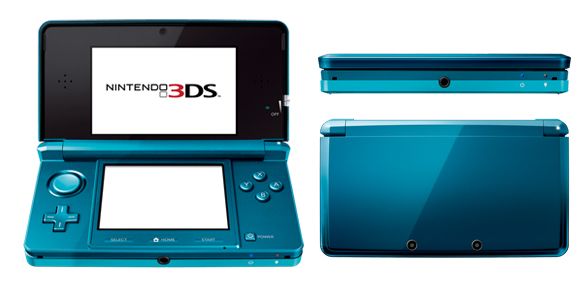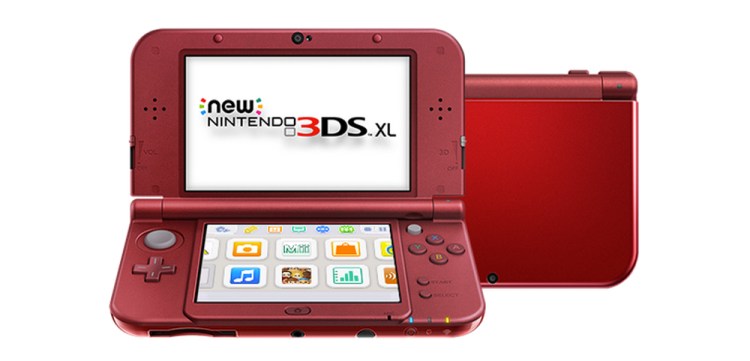
Above: Bring forth all of the screens.
Nintendo DS (2004)
The first DS was supposed to exist alongside the Game Boy Advance instead of replacing it, but it could play all of the games for the earlier system, so fans didn’t see a whole lot of reason to go back and forth between them.
It was cool; it had 100 percent more screens than any Nintendo handheld previously released, and one of them was touch-sensitive. It also had a microphone, and you could use Wi-Fi to play local multiplayer. And it had a big slot for Game Boy Advance cartridges, so that was also cool. Sure, it was a bit bulky, but apparently nobody cared because it sold like crazy.

Above: The Lite was more square than the DS, but not as square as the GBA SP.
Nintendo DS Lite (2006)
Of course, Nintendo wanted to streamline its latest gadget, so two years after the original console, we got this tiny-fied version that was smaller, more rectangular, and had a brighter screen. It didn’t quite have the adorable design of the Game Boy Advance SP, but it was pretty darn cute.
And then, things just got kind of silly.
Nintendo DSi (2008, worldwide in 2009)
The DSi was a larger version of the Lite that adds two halfway decent cameras and a bigger screen. It also removed the GBA slot, which meant that not only could gamers no longer play Game Boy Advance titles on it, but nor could they play select DS games that used that slot for peripherals. This would be things like Guitar Hero: On Tour, which carried most of its controls on an external gadget so that the screen was free for strumming.
OK, so maybe that wasn’t a huge loss, all told.
Nintendo DSi XL (2009)
A pattern has emerged here: A thing comes out, and then Nintendo makes a smaller version. That’s how it went for 20 years. But then, the developer said, “Let’s do the complete opposite of that.” And so we have the Nintendo DSi XL (LL in Japan), which had all of the same features of the DSi but in much greater proportion. The batteries lasted longer, the screens were twice the size, the viewing angle was wider, and the incidence of hand cramps in grown men trying to enjoy the Professor Layton series plummeted.

Above: The Nintendo DSi XL: now for grown-up hands.
It also came with a stylus the size of a fountain pen, and that was probably my favorite part of this hardware.
Nintendo 3DS (2011)
We’re almost caught up now with the release of the latest family of systems. The 3DS featured glasses-free 3D gameplay on its top screen and was backward compatible with original DS titles (although you could not get the cool visual effects on them). It introduced a slew of new online features like the friend-making StreetPass, an Internet browser, and compatibility with Nintendo’s Virtual Console, which allows you to purchase and play classic titles on the go.

Above: They made it shiny so that you’d want it. It still took a little while.
Because it was the first in the series, however, it had problems. In order to see the 3D images on the top screen, you had to maintain a proper distance, and the viewing angle was ridiculously small. It also lacked the second analog stick necessary to effectively play first-person shooters and other titles that benefit from giving players full control of the in-game camera.
Nintendo responded to this last issue by introducing the Circle Pad Pro, a cradle that adds another analog control on the right side as well as a few extra shoulder buttons. But players would have to wait to get that functionality built into the system itself.
Nintendo 3DS XL (2012)
In fact, they would even have to wait longer than the introduction of the supersized 3DS XL (LL once again in Japan) the following year. This plus-sized iteration had a screen almost twice as large as the original 3DS with the slight drawback that it displayed in the same resolution, so the graphics weren’t quite as crisp.
And yes, Nintendo made a larger Circle Pad Pro just for it.

Above: Guess it wasn’t big enough.
Nintendo 2DS (2013)

Above: It’s slightly less uncomfortable to hold than it looks. Slightly.
The 2DS was a bit of hardware that nobody either expected or really asked for, but it was an interesting experiment.
Nintendo created it as a budget-priced product for college kids who were low on money but still wanted to play Pokémon and for young children whose eyes were not sufficiently developed to handle the 3D graphics of its older siblings (it only displays games in 2D). It was kind of a modern version of the Micro, only it was less portable than the old models and had poorer sound quality.
And now, we’ve received the New Nintendo 3DS XL, which fixes both the 3D graphics and the second-analog problems. So we should be all set until the developer unveils its next generation of handhelds, which history says will be both incredibly exciting and somewhat flawed.
But don’t worry, currently unannounced gaming device: They’ll fix you. They fix everything.
VentureBeat's mission is to be a digital town square for technical decision-makers to gain knowledge about transformative enterprise technology and transact. Learn More

